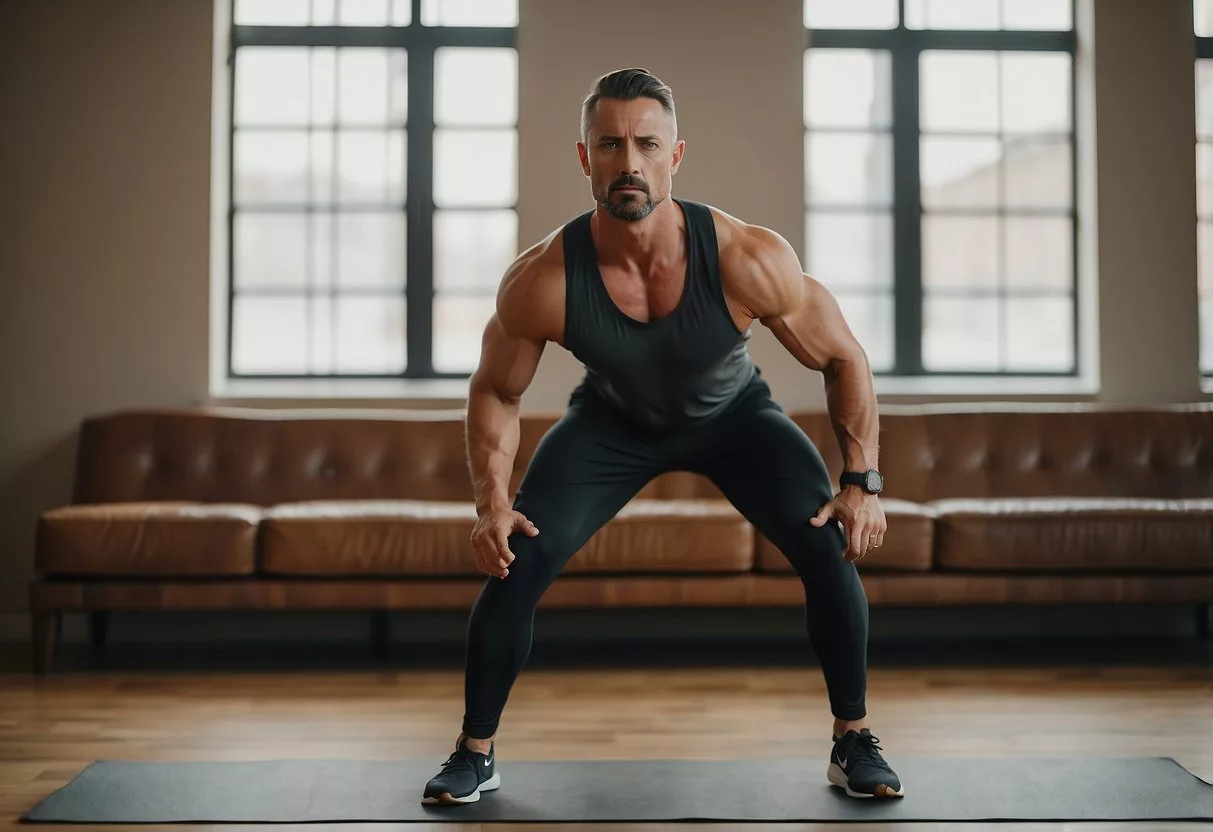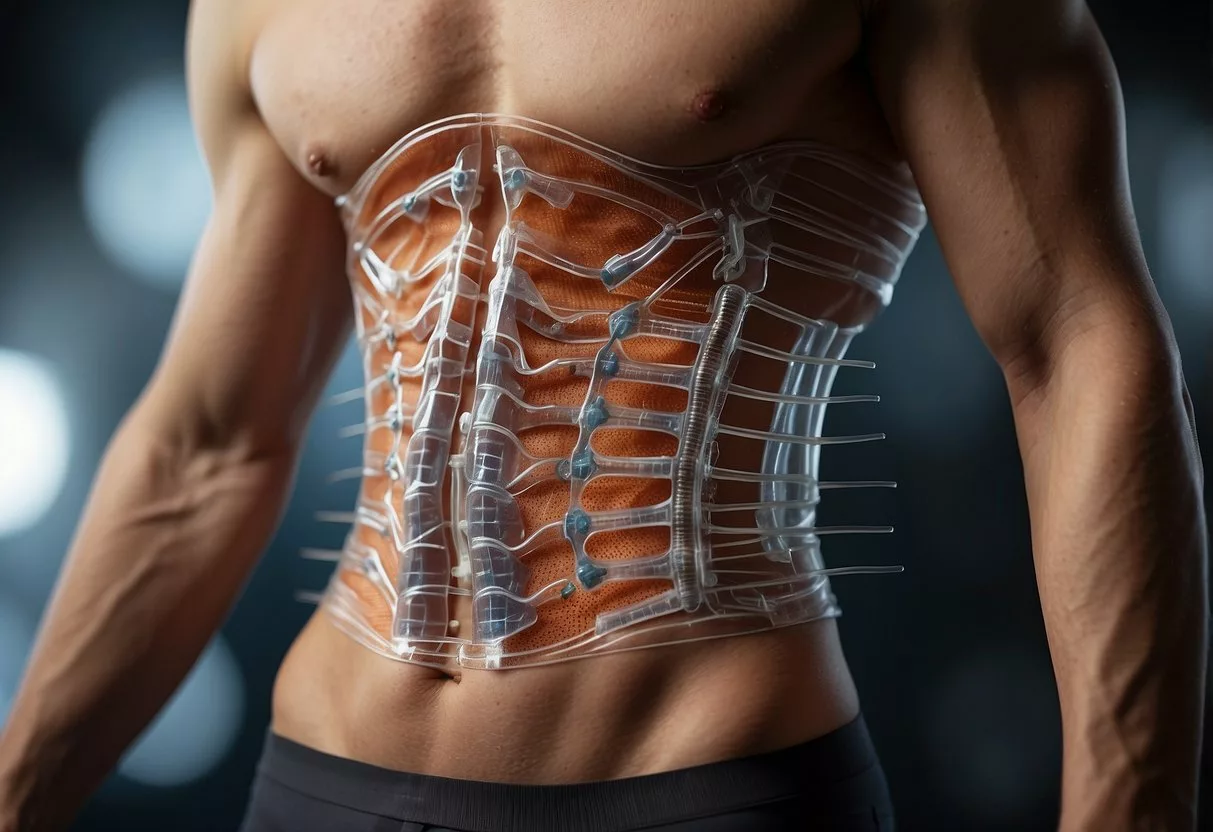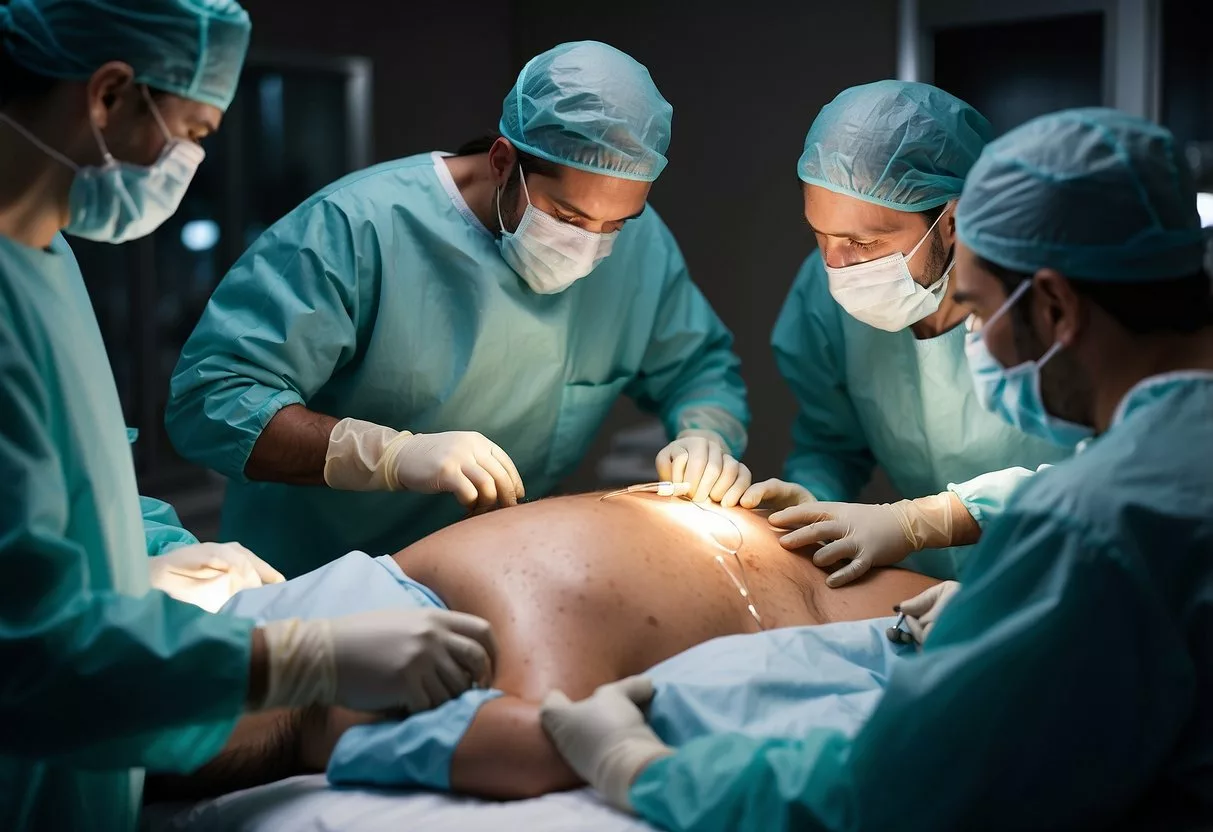Diastasis recti, often thought of as a condition affecting women postpartum, is also a significant problem for men. It involves the separation of the abdominal muscles, creating a gap that can weaken the core and lead to back pain and poor posture.
The good news is that diastasis recti can be fixed with targeted exercises and lifestyle adjustments. Understanding the causes and taking action with proper techniques can help men restore their core strength and improve their overall health.
Men can develop diastasis recti due to various factors, such as rapid weight gain or engaging in activities that put too much pressure on the abdominal area. Learning to spot and acknowledge these symptoms early is crucial.
By consistently performing exercises designed to knit those muscles back together, men can start to see improvements in their abdominal strength and stability.
In addition to exercises, it’s important to maintain a healthy lifestyle to prevent further complications. This includes avoiding heavy lifting and focusing on building a strong, functional core. With dedication and the right approach, men dealing with diastasis recti can regain their core integrity and overall physical fitness.
Key Takeaways
- Diastasis recti in men can be fixed with targeted exercises and lifestyle changes.
- Rapid weight gain and excessive pressure on the abdomen are common causes.
- Maintaining a healthy lifestyle and avoiding heavy lifting are crucial for prevention.
Understanding Diastasis Recti

Diastasis recti occurs when the rectus abdominis muscles located in the abdominal wall separate. This condition can lead to a noticeable bulge in the stomach area. It often results from increased pressure on the abdominal muscles.
Definition and Causes
Diastasis recti refers to the separation of the rectus abdominis muscles along the midline, known as the linea alba. The separation happens when the connective tissue is stretched due to various factors.
Common causes include excessive abdominal pressure from activities like heavy lifting or intense workouts. Men can also develop it due to weight gain, particularly around the abdomen. Unlike women, men do not have the additional risk factor of pregnancy, but similar pressures can lead to this condition.
Signs and Symptoms
Individuals with diastasis recti often notice a bulge or gap in their abdominal area, especially when straining or lifting. The separation can make the abdominal muscles less effective at stabilizing the core, leading to poor posture.
Common symptoms include discomfort or pain in the abdomen, swelling, and sometimes gastrointestinal issues like constipation. Another sign may be pain during specific activities that put pressure on the abdominal wall. In some cases, individuals might experience overall weakness in their core muscles.
Risk Factors
Factors that increase the likelihood of developing diastasis recti include weight gain and obesity, which put additional strain on the abdominal wall. Age can also be a factor as connective tissue becomes less resilient over time. Poor physical condition and improper exercise techniques can exacerbate the issue.
Posture plays a role as well, with poor posture contributing to the weakening and separation of the muscles. Activities that involve repeated straining or heavy lifting without proper support can lead to increased abdominal pressure, making separation more likely. Improving fitness through targeted exercises can help reduce these risks.
Diagnosis of Diastasis Recti

Diagnosing diastasis recti involves both physical examination and imaging techniques. These methods help healthcare providers determine the extent of abdominal muscle separation.
Physical Examination
A physical therapist or doctor will start with a physical exam to check for diastasis recti. The individual lies on their back and slightly lifts their head, causing the abdominal muscles to tighten. The examiner then uses their fingers to feel for any separation or bulging around the belly button area.
This method helps identify any gaps between the muscles. The number of fingers that fit into the gap is used to estimate the degree of separation. Sometimes, a tape measure or calipers can be used for a more precise measurement. These simple tools help assess the severity of the condition effectively.
Imaging Techniques
In some cases, physical examination alone is not enough. Imaging techniques like ultrasound and CT scans provide a clearer picture of the muscle separation.
An ultrasound is a non-invasive method that uses sound waves to create an image of the muscles, showing the exact location and extent of the gap.
If a more detailed view is needed, a CT scan might be used. This imaging technique takes cross-sectional images of the abdominal area, offering a comprehensive look at the muscles and any related issues. Both methods aid in accurately diagnosing and planning treatment for diastasis recti.
Non-Surgical Treatment Options
There are effective ways to manage and improve diastasis recti without surgery. These methods focus on strengthening the core, improving posture, and making lifestyle changes.
Exercise Program
Abdominal exercises play a crucial role in fixing diastasis recti in men. Specific diastasis recti exercises, such as abdominal bracing exercises, are essential. These exercises engage the deep core muscles and help in realigning the abdominal muscles.
Incorporating core exercises like planks, side planks, and controlled leg lifts can improve the stability of the core. Adding yoga and pilates can increase flexibility and strength while focusing on controlled movements. The Tupler Technique, which involves a series of targeted exercises and splinting the abdomen, is another effective method.
Watch the following video for diastasis recti exercises from a Doctor of Physical Therapy.
Workout Components:
- Core Exercises: Planks, side planks, leg lifts
- Diastasis Recti Exercises: Tupler Technique
- Yoga and Pilates: Controlled and gentle movements
Therapeutic Techniques
Seeing a physical therapist can enhance recovery from diastasis recti. Physical therapists can offer personalized exercise programs and manual therapy techniques. Techniques like myofascial release and deep tissue massage can help in reducing muscle tension and improving alignment.
Breathing exercises are also essential. Diaphragmatic breathing aids in engaging the pelvic floor and the deep core muscles, which is vital in repairing abdominal separation.
Therapeutic Approaches:
- Physical Therapy: Personalized exercise and manual therapy
- Breathing Exercises: Diaphragmatic breathing
- Manual Techniques: Myofascial release, deep tissue massage
Lifestyle Adjustments
Making certain lifestyle adjustments can support the healing of diastasis recti. Maintaining a healthy weight is crucial as excess weight can strain the abdominal region. Weight gain, especially in the abdominal area, can exacerbate the condition.
Good posture is also vital. Practicing proper posture reduces abdominal pressure and supports overall core strength. Avoiding activities that involve heavy lifting or intense abdominal strain is essential to prevent worsening of the separation.
Key Adjustments:
- Healthy Weight Maintenance: Prevent excess abdominal pressure
- Good Posture: Support core strength and reduce strain
- Activity Modification: Avoid heavy lifting and intense strain
Corrective Exercises
To fix diastasis recti in men, several exercises focus on strengthening the deep core muscles, improving pelvic floor function, and maintaining proper posture and alignment. These exercises help close the abdominal gap and restore core stability.
Core Strengthening
Core strengthening exercises are key to fixing diastasis recti. Planks, heel slides, and glute bridges are effective options.
- Planks: Start on hands and knees, then lift knees to form a straight line from head to heels. Engage abs and hold.
- Heel Slides: Lie on your back, knees bent, feet flat. Slide one heel forward, keeping core engaged. Return to start and switch sides.
- Glute Bridge: Lie on your back with knees bent. Lift hips to form a straight line from knees to shoulders. Squeeze glutes and hold.
These exercises target the transverse abdominis and other deep core muscles, enhancing overall core stability.
Pelvic Floor Workouts
Strengthening the pelvic floor is crucial for men with diastasis recti. Kegel exercises are particularly effective.
- Kegel Exercises: Tighten pelvic floor muscles as if preventing urine flow. Hold for a few seconds, then relax. Repeat multiple times.
- Single-Leg Lifts: Lie on your back with one knee bent, other leg straight. Lift the straight leg while engaging the pelvic floor and core.
Posture and Alignment
Maintaining proper posture and alignment can prevent further damage to the abdominal and pelvic muscles.
- Standing Posture: Keep shoulders back, spine neutral, and weight evenly distributed on both feet. Avoid slouching or leaning forward.
- Seated Posture: Sit with feet flat on the floor, knees at a 90-degree angle. Keep back straight and shoulders relaxed.
Proper alignment ensures the muscles work efficiently and reduces strain on the abdominals and pelvic floor.
Training these muscles helps men fix diastasis recti and improve their core health. Regular practice and focusing on techniques are key to success.
Surgical Treatments

Surgery for diastasis recti in men is often recommended when non-surgical methods fail to provide relief or improve muscle alignment. Two key surgical options are usually discussed, and the recovery process is critical for effective healing and maintaining long-term results.
Indications for Surgery
Surgery may be necessary for men who experience severe muscle separation, leading to functional problems like back pain or hernias. Exercises and physical therapy often help, but they may not be enough for large separations. Cosmetic concerns, especially after significant weight loss, can also prompt surgery.
Persistent discomfort and the inability to achieve core stability through other means are strong indicators for considering surgical options. A healthcare professional specializing in abdominal health usually evaluates and makes the decision.
Types of Surgery
The most common surgical treatment is an abdominoplasty, also known as a tummy tuck. This procedure not only tightens the abdominal muscles but also removes excess skin. In some cases, minimally invasive techniques are used, though these might be less effective for severe cases.
A full abdominoplasty involves making an incision between the hip bones, tightening the muscles, and removing extra skin. Some procedures are combined with hernia repairs if hernias are present. The specifics of the surgery depend on the extent of muscle separation and any additional complications.
Post-Surgical Recovery
Recovery involves a period of rest and limited physical activity. Patients may need to wear compression garments to support the healing tissue and reduce swelling. Pain management is crucial during the first few weeks.
It’s important to follow the surgeon’s guidelines on physical activity. Light walking is often encouraged to promote blood flow, but strenuous activities and exercises should be avoided until cleared by the doctor. Full recovery can take a few months, during which patients might gradually return to their regular activities and exercises under professional guidance.
Regular follow-ups with the surgeon ensure that the muscles are healing correctly and that there are no complications like infections or poor tissue healing. Proper recovery care helps maximize the benefits of the surgery and maintain the functional improvements achieved.
Prevention and Management
Preventing diastasis recti and maintaining core strength requires a balanced approach involving proper exercises, fitness routines, and lifestyle adjustments. Implementing preventive measures and following a consistent care plan can minimize the risk of abdominal separation.
Preventing Diastasis Recti
Preventing diastasis recti in men involves focusing on strengthening the core muscles. Regularly engaging in suitable exercises like planks and side planks can help. It’s important to avoid heavy lifting that puts excessive pressure on the abdominal area.
Maintaining good posture is also key, as slouching or hunching can strain the abdominal muscles. Men should also be cautious about rapid weight gain, especially around the belly, as weight gain can increase the risk of developing diastasis recti.
A balanced diet rich in nutrients supports muscle health and prevents obesity, which can further strain the core. Incorporating lifestyles changes like regular physical activity and mindfulness about body mechanics can significantly lower the chances of diastasis recti.
Long-Term Care and Maintenance
Maintaining a routine that includes core-strengthening exercises is essential for long-term care. Specific exercises, such as quadruped tilts or wall sit-ups, can be beneficial. It’s crucial to consult with fitness professionals to ensure exercises are performed correctly.
Monitoring progress and adjusting the exercise program helps in maintaining results. Men should also be aware of the signs of recurring diastasis recti, such as a bulging belly or pain during abdominal activities. Wearing supportive belts or binders might aid recovery in severe cases.
Practicing consistency with lifestyle changes, including proper diet, regular exercise, and maintaining a healthy weight, will support core strength. Keeping a check on posture and avoiding activities that cause undue pressure on the abdomen is equally important for long-term management.
Frequently Asked Questions

Addressing diastasis recti in men involves understanding the correct exercises, recognizing symptoms, and knowing what movements to avoid. Proper exercises can lead to noticeable improvements over time.
What exercises can help improve diastasis recti in men?
Exercises like side planks and quadruped tilts can be beneficial. For example, side planks involve lying on your side, lifting your hips, and holding the position. Another effective exercise includes quadruped tilts, where you start on your hands and knees, draw in your abdomen, and tuck your pelvis.
Can diastasis recti be repaired without surgery in men?
Yes, diastasis recti can often be repaired with dedicated core exercises that target the abdominal muscles. Consistent practice of these exercises over time can help bring the muscles back together and reduce the gap.
What are the symptoms of diastasis recti in men?
Symptoms include a bulging or tenting of the abdominal wall during activities like sit-ups, coughing, or straining. Men may also notice a visible gap between the rectus muscles when lying down and lifting their head.
Are there specific exercises men should avoid when dealing with diastasis recti?
Men should avoid exercises that cause the abdomen to bulge outward, such as traditional sit-ups and crunches. Heavy lifting and any workouts that increase intra-abdominal pressure can also make the condition worse.
What causes the diastasis recti bulge in men?
Diastasis recti bulge is caused by the separation of the rectus muscles in the abdominal wall. This separation allows the abdominal contents to push forward, creating a noticeable bulge. Factors like excessive abdominal pressure, rapid weight gain, and intense physical activity contribute to this condition.
How quickly can men see improvement in diastasis recti with proper exercise?
Improvements can vary. With consistent and correct exercise, men might start seeing changes within a few weeks to a few months.
The key is regular practice and proper technique. These ensure effective muscle engagement and healing.